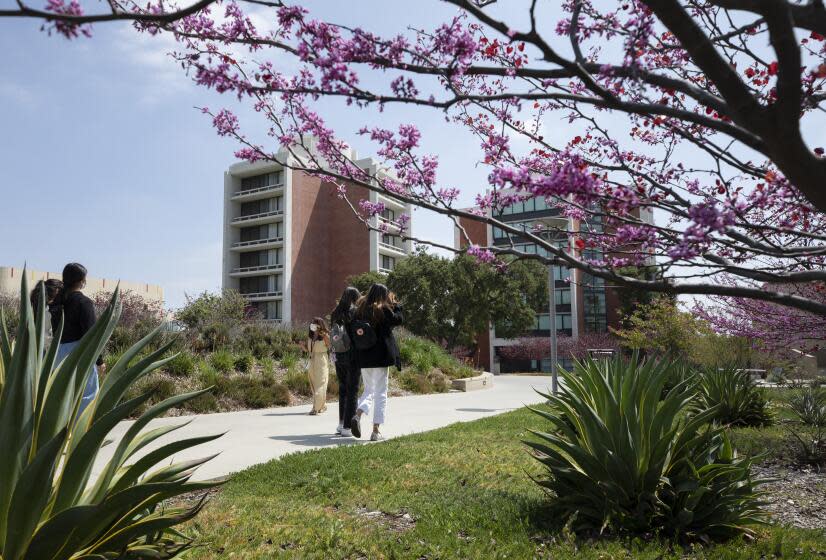Editorial: Early decision admissions for college unfairly favor wealthy students

The 2023 death of affirmative action in college admissions at the hands of the U.S. Supreme Court had at least one positive effect: It finally focused attention on the inherently biased system for getting a higher education. Not biased toward people of color, but toward people of privilege, most of whom are white.
Those biases include legacy admissions, in which applicants with a close relative who attended the school are given preferential treatment, which also is extended to those whose parents have donated to the school or who have connections to high-ranking college officials. Athletic admissions is another area where privileged white applicants have the upper hand — not in the popular sports of football, basketball and soccer, which are widely available to students at most public high schools, but in golf, fencing, equestrian, gymnastics, crew and the like. This created a convenient side door for the 2019 Varsity Blues scandal, in which athletic coaches were bribed to say that certain students were desirable athletes, when they had no such background.
Read more: Editorial: Free speech or discrimination? Colleges need help drawing the line
In the last couple of years, a handful of schools have dropped legacy admissions and even cut a few sports teams. That's good, but the use of another college admissions practice that favors wealthy students has been growing: early decision. About 200 colleges, which tend to be private and highly selective, offer students a chance to file early applications and get a decision from the school by mid-December. Nine of those are in California. In exchange, students commit when they apply to attending that school if accepted.
This process offers a better chance of being admitted. In schools with low admission rates, the difference can be significant. For example, at the University of Pennsylvania, the regular acceptance rate is 5%. It’s more than triple that for those applying through early decision, according to the admissions consulting company College Transitions.
Even more colleges offer something called early action, which involves giving applicants an early answer without requiring a commitment to attend. But these tend to be used mostly by less-selective colleges that are not as likely to be a student's top choice. They also offer a smaller boost in acceptance rates.
Read more: Editorial: The demise of liberal arts? Students lose when colleges trade humanities for STEM
But colleges are the big beneficiaries of this scheme. It allows them to have a certain number of first-year spots filled. That means less guesswork about how many students to accept to reach a target enrollment (colleges offer admission to more students than needed to fill a class because some accepted students will pick another school). Many students applying early decision are going to attend even if the financial package is less than ideal, which helps the colleges financially. In addition, it means colleges can reduce their acceptance rates for regular-decision applicants, which is a prestige point for some college rankings.
No wonder the use of early decision has increased. A 2022 report by the nonprofit Education Reform Now shows that the numbers of applicants accepted through early decision rose sharply from 2015 to 2020. In the case of Pitzer College in Claremont, 44% of students admitted in 2015 came through early decision; by 2020, the number had risen to 79%. Obviously, there weren’t many seats left over for students who applied through regular admissions.
Why should we care? Everybody wins, right?
Read more: Inside the audacious college scheme to get kids of the rich and famous into elite schools
Not quite. Low-income and middle-class students who rely on generous financial aid to attend college are less able to take advantage of early decision, because they have less wiggle room on financial aid. If a college’s offer falls short of their expectations, they can appeal. But unless the college hasn’t met their financial need — a decision that might be made by the financial aid office, not by the student — backing out can be difficult. In regular decision, students can compare financial aid offers from a variety of schools, and negotiate based on offers they’ve received elsewhere.
Lower- and middle-income students are far less likely to apply via early decision. The 2022 report found that students who had attended private high schools — usually with parents able to pay high tuition bills — were more than 3.5 times more likely to apply under early decision than those in public schools.
Despite that economic disparity, early decision is expanding even beyond its original concept. A growing number of colleges are offering Early Decision 2, in which students apply during the regular application period, but nonetheless commit to accepting an offer from that college if accepted. ED2, as it’s called, offers applicants a much smaller boost in acceptance rates — and has the same problem with the inability to compare financial aid offers.
In other words, colleges are moving in the wrong direction on early decision. They should reconsider how many students are admitted via these early commitments, offer financial aid that fully meets the need for those accepted and question the practice altogether when an applicant pool is disproportionately well-off.
This story originally appeared in Los Angeles Times.

